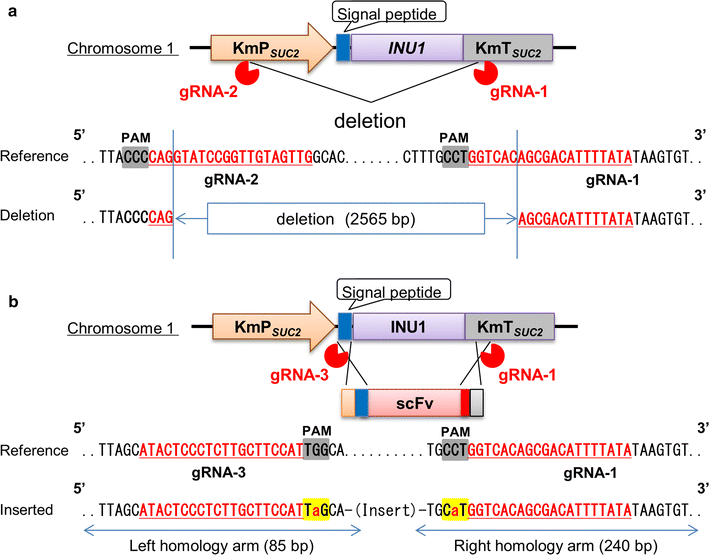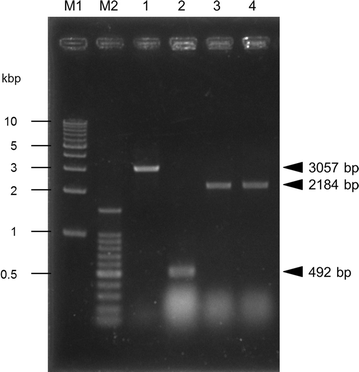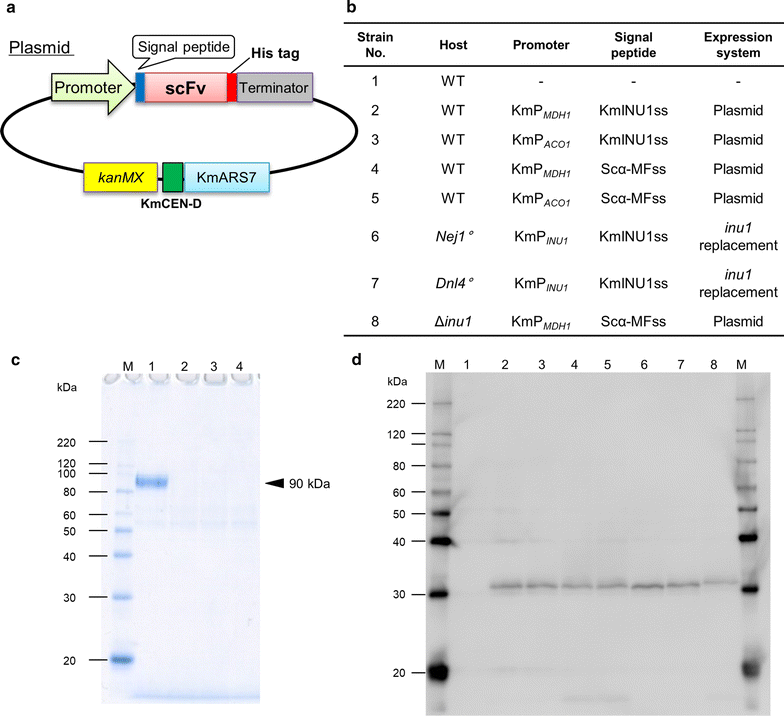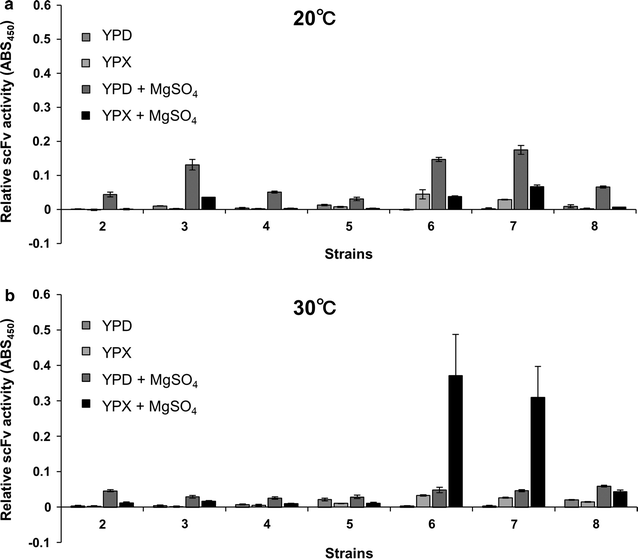Genetic and physiological basis for antibody production by Kluyveromyces marxianus
- PMID: 29651657
- PMCID: PMC5897269
- DOI: 10.1186/s13568-018-0588-1
Genetic and physiological basis for antibody production by Kluyveromyces marxianus
Abstract
Kluyveromyces marxianus is a thermotolerant, crabtree-negative yeast, which preferentially directs metabolism (e.g., from the tricarboxylic acid cycle) to aerobic alcoholic fermentation. Thus K. marxianus has great potential for engineering to produce various materials under aerobic cultivation conditions. In this study, we engineered K. marxianus to produce and secrete a single-chain antibody (scFv), a product that is highly valuable but has historically proven difficult to generate at large scale. scFv production was obtained with strains carrying either plasmid-borne or genomically integrated constructs using various combinations of promoters (P MDH1 or P ACO1 ) and secretion signal peptides (KmINUss or Scα-MFss). As the wild-type K. marxianus secretes endogenous inulinase predominantly, the corresponding INU1 gene was disrupted using a Clustered Regularly Interspaced Short Palindromic Repeat (CRISPR)-associated protein (CRISPR-Cas9) system to re-direct resources to scFv production. Genomic integration was used to replace INU1 with sequences encoding a fusion of the INU1 signal peptide to scFv; the resulting construct yielded the highest scFv production among the strains tested. Optimization of growth conditions revealed that scFv production by this strain was enhanced by incubation at 30 °C in xylose medium containing 200 mM MgSO4. These results together demonstrate that K. marxianus has the potential to serve as a host strain for antibody production.
Keywords: INU1; Inulinase; Kluyveromyces marxianus; MgSO4; Single-chain antibody (scFv).
Figures




Similar articles
-
Engineering Kluyveromyces marxianus as a Robust Synthetic Biology Platform Host.mBio. 2018 Sep 25;9(5):e01410-18. doi: 10.1128/mBio.01410-18. mBio. 2018. PMID: 30254120 Free PMC article.
-
Enhanced production of extracellular inulinase by the yeast Kluyveromyces marxianus in xylose catabolic state.J Biosci Bioeng. 2018 Jun;125(6):676-681. doi: 10.1016/j.jbiosc.2017.12.024. Epub 2018 Jan 20. J Biosci Bioeng. 2018. PMID: 29370981
-
Kluyveromyces marxianus as a host for heterologous protein synthesis.Appl Microbiol Biotechnol. 2016 Jul;100(14):6193-6208. doi: 10.1007/s00253-016-7645-y. Epub 2016 Jun 3. Appl Microbiol Biotechnol. 2016. PMID: 27260286 Review.
-
Overexpression of Endogenous Xylose Reductase Enhanced Xylitol Productivity at 40 °C by Thermotolerant Yeast Kluyveromyces marxianus.Appl Biochem Biotechnol. 2019 Oct;189(2):459-470. doi: 10.1007/s12010-019-03019-9. Epub 2019 May 2. Appl Biochem Biotechnol. 2019. PMID: 31044368
-
Kluyveromyces marxianus: a potential biocatalyst of renewable chemicals and lignocellulosic ethanol production.Crit Rev Biotechnol. 2021 Dec;41(8):1131-1152. doi: 10.1080/07388551.2021.1917505. Epub 2021 May 2. Crit Rev Biotechnol. 2021. PMID: 33938342 Review.
Cited by
-
RNA polymerase II-driven CRISPR-Cas9 system for efficient non-growth-biased metabolic engineering of Kluyveromyces marxianus.Metab Eng Commun. 2022 Sep 24;15:e00208. doi: 10.1016/j.mec.2022.e00208. eCollection 2022 Dec. Metab Eng Commun. 2022. PMID: 36249306 Free PMC article.
-
Comparative metabolome and transcriptome analyses of the properties of Kluyveromyces marxianus and Saccharomyces yeasts in apple cider fermentation.Food Chem (Oxf). 2022 Mar 8;4:100095. doi: 10.1016/j.fochms.2022.100095. eCollection 2022 Jul 30. Food Chem (Oxf). 2022. PMID: 35415699 Free PMC article.
-
CRISPRi-induced transcriptional regulation of IAH1 gene and its influence on volatile compounds profile in Kluyveromyces marxianus DU3.World J Microbiol Biotechnol. 2024 Mar 5;40(4):121. doi: 10.1007/s11274-023-03811-0. World J Microbiol Biotechnol. 2024. PMID: 38441729
-
Bioprospecting Kluyveromyces marxianus as a Robust Host for Industrial Biotechnology.Front Bioeng Biotechnol. 2022 Apr 20;10:851768. doi: 10.3389/fbioe.2022.851768. eCollection 2022. Front Bioeng Biotechnol. 2022. PMID: 35519613 Free PMC article. Review.
-
Growth and autolysis of the kefir yeast Kluyveromyces marxianus in lactate culture.Sci Rep. 2021 Jul 15;11(1):14552. doi: 10.1038/s41598-021-94101-y. Sci Rep. 2021. PMID: 34267270 Free PMC article.
References
-
- Brachmann CB, Davies A, Cost GJ, Caputo E, Li J, Hieter P, Boeke JD. Designer deletion strains derived from Saccharomyces cerevisiae S288C: a useful set of strains and plasmids for PCR-mediated gene disruption and other applications. Yeast. 1998;14(2):115–132. doi: 10.1002/(SICI)1097-0061(19980130)14:2<115::AID-YEA204>3.0.CO;2-2. - DOI - PubMed
LinkOut - more resources
Full Text Sources
Other Literature Sources
Research Materials
Miscellaneous

